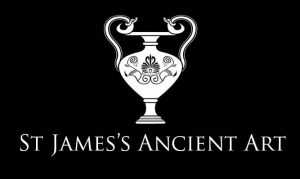Bronze or silver statuettes were popular across the Roman Empire, usually modelled in the shape of gods, goddesses and animals. Such statuettes could have been part of private households or placed in temples as votive offerings.
The cult of Isis emerged in Roman religion from the 2nd century BC, following centuries of increasing popularity for the goddess beyond Egypt. She was worshipped both in her own right and also in syncretism with other Roman goddesses, creating new composite deities, such as Isis-Fortuna. In the Ancient Roman pantheon, Fortuna, the equivalent of Greek Tyche, was the goddess of fortune, good luck and fertility, while Isis was worshipped for her powers related to the afterlife. Bronze statuettes of Isis-Fortuna, such as this fine example, would have featured attributes of both deities, such as the Isis knot tied to her robes and the headdress of Isis, a lunar disk between horns or feathers, and Fortuna’s rudder and cornucopia.
Roman presence in Egypt was prevalent from the 1st century BC until the end of the empire. Egypt was a crucial territory for resources as well as for stronger trade routes to the African continent, the Near East and India. The popularity of Isis in Rome and her amalgamation with traditional Roman goddesses reflect the increased cultural exchange between the two civilisations. Statuettes such as these are a testament to the inter-connectivity of civilisations in the ancient world.












